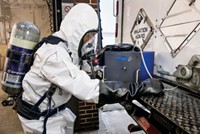Advertisement
Grab your lab coat. Let's get started
Welcome!
Welcome!
Create an account below to get 6 C&EN articles per month, receive newsletters and more - all free.
It seems this is your first time logging in online. Please enter the following information to continue.
As an ACS member you automatically get access to this site. All we need is few more details to create your reading experience.
Not you? Sign in with a different account.
Not you? Sign in with a different account.
ERROR 1
ERROR 1
ERROR 2
ERROR 2
ERROR 2
ERROR 2
ERROR 2
Password and Confirm password must match.
If you have an ACS member number, please enter it here so we can link this account to your membership. (optional)
ERROR 2
ACS values your privacy. By submitting your information, you are gaining access to C&EN and subscribing to our weekly newsletter. We use the information you provide to make your reading experience better, and we will never sell your data to third party members.
Analytical Chemistry
Purge and Trap Turns 30
Analyte concentrator for gas chromatography enabled part-per-billion analysis of volatile organics
by Mitch Jacoby
December 12, 2005
| A version of this story appeared in
Volume 83, Issue 50

Necessity is the mother of invention. So says the old adage.
In Thomas A. Bellar's case, it was the Environmental Protection Agency that was in need of an analytical method to test wastewater for pollutants at the microgram-per-liter (or part-per-billion) level. As a research chemist in the 1970s working at EPA's Methods Development & Quality Assurance Research Laboratory in Cincinnati, Bellar was assigned the task of finding a sufficiently sensitive analytical method. He met the challenge by inventing the purge-and-trap system-an analyte concentrator for gas chromatography that was first commercialized 30 years ago.
Bellar's forte was trace-gas analysis. The EPA chemist, who retired more than 10 years ago, had just switched from air pollution to water analysis at the time the part-per-billion challenge was put to his lab.
"I thought if I could get the compounds from the water into the air, I could do the analysis," Bellar recalls. So he rummaged through the lab collecting spare parts, pieces of glassware, and porous-polymer traps used in air pollution studies. "I did a little glass blowing and was ready to try it out."
In Bellar's device, which he says was "crude and cost almost nothing," an inert gas was bubbled through an aqueous sample to purge the liquid of volatile organic compounds. The gas transferred the analytes to the headspace above the liquid and then carried them to a sorbent trap, where they accumulated. After a prescribed collection period, the trap was heated to desorb the analytes. Then the species were injected into a GC column, separated, and detected.
"To my surprise, it worked very well," Bellar says. He found that benzene, decane, and other volatile test compounds were transferred to the gas phase quickly. And it wasn't long before a number of compounds could be detected at the 1-ppb level. "God must have been with me that day," he jokes.
Near the end of 1974, Bellar and EPA coworker James J. Lichtenberg described the purge-and-trap instrument and the GC method for using it in the Journal of the American Water Works Association. Around the same time, Tekmar Co. (now Teledyne Tekmar), Mason, Ohio, learned of the new technology from Bellar. By the following year, Tekmar had built a prototype and sold the first five commercial Liquid Sample Concentrator LSC-1 units.
An unexpected finding led the new purge-and-trap's popularity to grow quickly. As Bellar tells the story, he was troubled by background interferences that he traced to tap water used for sample preparation. Eventually, he determined that standard drinking-water purification processes involving chlorine led to formation of low levels of CHCl3, CHBrCl2, CHBr2Cl, and other halogenated compounds.
"It was quite a surprise to find bromine compounds in drinking water," Bellar notes. He explains that the species were formed in reactions between chlorine and naturally occurring humic acids and bromide ions. The finding touched off a nationwide study and led to legislation that mandated use of the purge-and-trap GC method for water analysis.
"Nowadays, there are thousands of purge-and-trap units worldwide," says Eric T. Heggs, a project manager at Teledyne Tekmar. The latest unit, Velocity XPT, works much faster than its predecessors and can be used with a 70-plus-position autosampler, he says. Not only that, Heggs comments, but the software that runs the device "can page you or send you an e-mail when the job is finished."



Join the conversation
Contact the reporter
Submit a Letter to the Editor for publication
Engage with us on Twitter